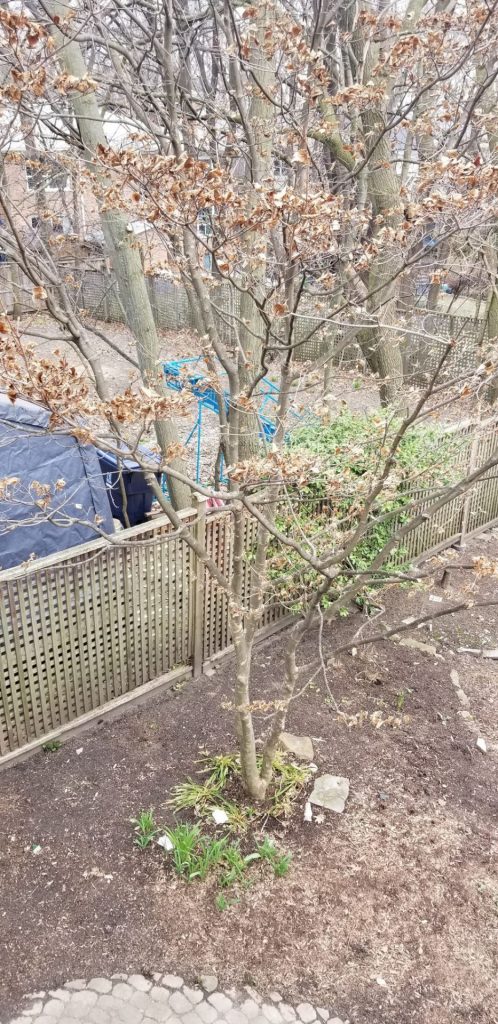
Hi,
I would like to please ask you a question about a kousa dogwood.
Let me give you first some background.
The soil is sandy, and the backyard is lightly sloped and mostly shaded. There is a mature kousa dogwood in a dappled area of the property. Most of my backyard is part of the protected ravine system, and the kousa sits at the very edge of that protected area.
Over the last years, I did a fair amount of landscaping in the garden, mostly removing invasive plants and weeds: garlic mustards, english ivy, lily of the valley, siberian scilla, etc. I also planted native plants in many parts of the garden with some mixed success. My goal is to one day create a woodland garden.
About 3 metres away from the the kousa, on the other side of the fence, there are mature oaks and mulberries as well as a large lilac and young scottish elms. The neighbour has a construction project going on since last year, and the contractor uses the space near the fence and the trees for storing equipment and construction material.
Last fall, the kousa dogwood didn’t shed its leaves. We are in April and the leaves from last year are still attached to the tree. The tree had always looked healthy in the past.
I read that dogwoods don’t like to be disturbed, and it is likely that I did so by digging out weed and replacing them with native plants. My husband also did some pruning last year.
I would like to know your opinion regarding this tree. Do you think this tree is in distress?
If so what would you recommend that I do to bring it back to health?
Thank you for answering my request.
Thank you or contacting the Toronto Master Gardeners.
You are not alone in asking this question, the following is our response to a similar question concerning dogwood:
Your tree is exhibiting leaf marcescence, where leaves wither and die but don’t fall off. In order for leaves to drop in the autumn, deciduous trees develop a separation layer (called the abscission zone) between leaf stalks and tree branches, so that leaves can break off without harming branches.
It is most likely that when your garden was hit early and suddenly with abnormally early freezing conditions early this past autumn, your tree had not yet finished the process of developing that separation layer, and many of the leaves died while still attached to the tree. In other words, the abscission process was stopped in its tracks, resulting in dead, crispy leaves remaining on the branches.
It’s not clear why leaf marcescence occurs – one theory holds that this helps prevent leaf buds from drying out over winter. And, as the leaves will eventually fall off and decompose come spring, this process could also be helpful for the tree, by providing a source of nutrients or acting as a mulch to prevents moisture from evaporating.
Be vigilant come spring. Watch for diseases, e.g., the dead tissues at the tips of new shoots can be a breeding ground for fungi. It is possible that you may not see flowers on the affected branches this year, although your tree may bloom as usual. The dogwood has been stressed, and may appreciate extra watering and fertilizing, to help speed its growth and make it more resistant to infections.
All the best in tending to your lovely tree. We would appreciate an update from you in the late spring on whether your dogwood bloomed as usual or whether some of the blooms were indeed affected.
You may be interested in reading our Gardening Guide on: Blooming Trees and Shrubs
Every tree, shrub or perennial will benefit from the yearly addition of compost. organic compost will not only improve the quality of the soil it also adds much needed nutrients to your tree and perennials. Also, the addition of a layer of mulch will help retain moisture, prevent erosion, regulate soil temperature and suppresses weeds. When adding mulch make sure to keep the mulch a few inches away from the tree trunk.

